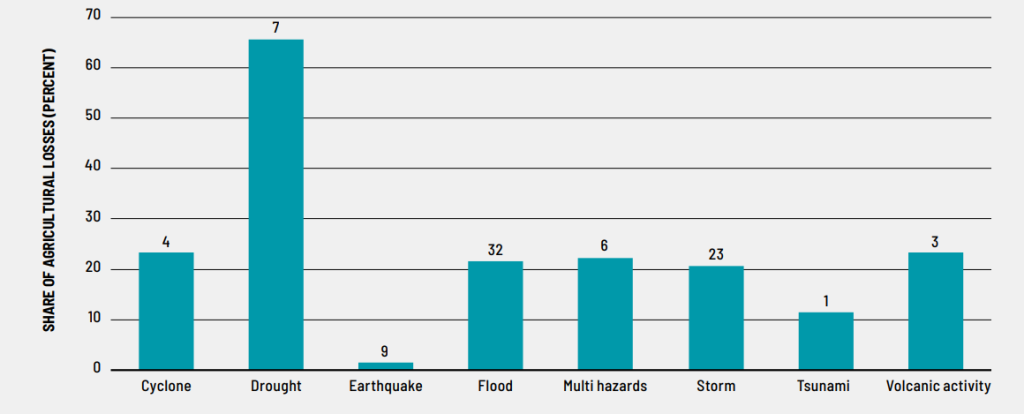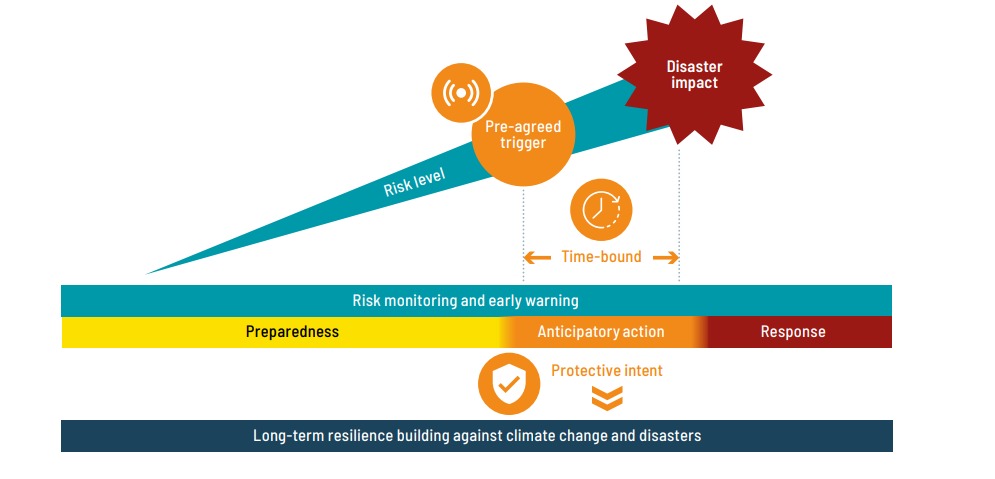Introduction
The increasing frequency and intensity of disaster events (Fig. 1) is causing unprecedented amounts of damage and loss in agriculture worldwide. These negative repercussions ripple down value chains, affecting agrifood systems across various dimensions, jeopardizing food security, and harming agriculture’s sustainability.
In 2023, the FAO released a report on “The impact of disasters on food security and agriculture” with the aim of providing the latest data on the impact of disasters and crises on the agricultural sector. Furthermore, the report presents a compelling argument for investing in catastrophe risk reduction and resilience, particularly data collection and analysis for evidence-informed action. Additionally, it advocates a disaster impact monitoring and assessment culture as an essential component of effective disaster risk reduction (DRR) policy and action.

Report framework
The FAO report is based on the following definitions:
- Hazard: Process, phenomenon, or human activity that may cause loss of life, health impacts, or social and economic disruption. An overview of hazards can be seen in Table 1.
- Exposure: Describes the situation of people and human assets located in hazard-prone areas.
- Vulnerability: The conditions determined by physical, social, economic, and environmental factors that increase the susceptibility to a hazard.

Impact of extreme events on agriculture and food security
It is estimated that in the past 30 years, 3.8 trillion has been lost in agriculture due to disastrous events. Furthermore, research shows that this trend has been drastically increasing in the past 30 years.
Agricultural loss does not just mean economic loss but also translates into an average of 147 kcal per person of lost nutrient availability each day.
The impacts of extreme events on agriculture are complex to understand, as they are multidimensional, interconnected, and cascading. Fig. 2 shows a complete overview of the disasters affecting agriculture.

Global losses in crops and livestock products
Worldwide, all major crop and livestock product groupings show increasing trends in their losses. Significant differences in agricultural losses in different countries can be found due to pre-existing social and environmental factors as well as the resilience or vulnerability of agriculture and agricultural communities in coping with catastrophe risk, disasters have varying effects on different regions and countries.
- On average, each year amounts to about 123 billion in global losses in agricultural goods
- Cereal production is the most affected (accounting for 69 million tons per year), followed by fruit and vegetable production.
- Economic losses might be greater for high-income countries because of higher costs of goods, but for low-income countries the ability to recover from a shock is likely lower, generating knock-on effects.
- From 1991-2021, Asia had the largest economic loss.
Assessment of global agricultural losses
Data on the impact of catastrophes on agriculture and agrifood systems is insufficient and inconsistent. Currently, two sets of approaches are utilized to collect information on agricultural disaster losses:
- Surveys of post-disaster needs (PDNA).
- FAO and OHCHR developed “Measurement of Disasters Risk Reduction” C2 of the Sendai Framework Monitor’s indicator.
Disaster risk drivers and cascading impacts
The world is more interconnected than ever before, and so are food systems. As a result, the food chain’s susceptibility to shocks has grown. Therefore, disaster risk assessment should also include the impact of disaster cascades within the sector and different geographic areas. FAO identified three main risk drivers, which description will follow.
1. Climate change
Climate change is contributing to an increase in hazard incidence. Increased vulnerability and exposure are direct results of that. The consequences are:
- Loss of crops and production
- Diminished copying capacity of individuals and systems
- Cascading effects
-> To assess the degree to which climate change is negatively impacting agriculture production and food security, the attribution science approach has been employed. The investigation revealed negative yield implications ranging from 2-10%.
2. Pandemics and Epidemics
Pandemics and epidemics do not only have an influence on human lives but can also affect agrifood systems through cascading effects. The FAO report focuses on two recent events: COVID-19 and the African Swine Fever. The analysis of these specific events, evidenced that:
- The COVID-19 pandemic affected farmers by denying them access to markets and moreover by creating labor shortages. Some planted areas suffered a reduction of up to 50%.
- In 2019-2020, ASF caused social economic losses by affecting pork production. Especially in China, where production decreased by 26%.
-> As a result of this, cascading effects such as reduction of household incomes, decreased buying capacity and increased prices all contributed to affecting food security.
Conflicts
The past years have seen a rise in active armed conflicts, which are at the highest level since the Second World War. Recent evaluations in Somalia, Syria, and Ukraine show that armed conflicts have a considerable impact on agricultural and food security.
-> To read more about how conflict can affect the agrifood value chain, read this article based on a FAO summary:
Disaster risk solutions to support food security
Disasters are not occurring daily but preventing hazards from triggering them must become the goal. According to FAO, the following actions are to be performed to achieve an effective prevention of hazards:
- Generating better and actionable risk information and analysis
- Strengthening disaster and climate risk governance
- Increasing investments in risk reduction for resilience
- Enhancing preparedness and anticipatory action capacities
-> Particularly, anticipatory actions are measures in place to better prepare in the event of a disaster. Anticipatory actions consist of agreed “early warning triggers” that would signal that a hazard is likely to occur. Anticipatory actions have proven to be an effective and cost-effective investment.

Conclusions
Creating a more comprehensive and ambitious disaster-resilience framework for agriculture is critical to ensuring long-term growth. This strategy is a pillar of peace and the foundation for climate change adaptation and food security. To achieve this, according to FAO, the following points should be improved:
- Research on the impact of disasters on food security is being hindered by a lack of data, therefore investment in data monitoring is essential.
- Standard tools to measure the impact of disasters should be implemented.
- A more sector and subsector-specific approach should be promoted.
- Finally, a mainstream multihazard disaster risk approach should be implemented and translated into policy and programming.
To learn more about the current state of food security worldwide, read this summary article based on a FAO report.
Source
FAO. 2023. The Impact of Disasters on Agriculture and Food Security 2023 – Avoiding and reducing losses through investment in resilience. Rome.
Related articles to Impact of disasters on food security
Many customers and visitors to this page 'Impact of disasters on food security' also viewed the articles and manuals listed below:
